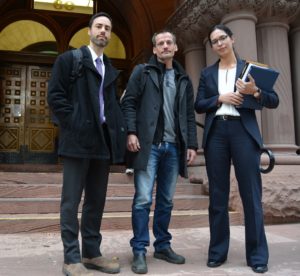Failures to report on methylmercury, a neurotoxin, prompt legal action
(Toronto) Wildlands League, assisted by Ecojustice lawyers, has filed a private prosecution against De Beers Canada Inc. for failing to report levels of mercury and methylmercury at its Victor Diamond Mine site in northern Ontario. Methylmercury, a neurotoxin, can threaten the health of human and aquatic life.
Wildlands League alleges that De Beers failed to report properly on mercury levels from five out of nine surface water monitoring stations for the creeks next to its open pit mine between 2009 and 2016, violating a condition of its Certificate of Approval. These are offences under subsection 107(3) of the Ontario Water Resources Act.
Trevor Hesselink (middle) assisted by Ecojustice lawyers Charles Hatt (l) and Julia Croome (r) after the swearing of information at Old City Hall.
“Private prosecutions are an important tool that allows private citizens to hold industry to account,” said Julia Croome, Ecojustice lawyer. “When governments don’t enforce their own laws, this course of action is in the public interest,” Croome added.
The reporting failures undermined the effectiveness of the mine’s early warning system for mercury pollution, Ecojustice lawyers assisting the group say.
De Beers’ plans include extending the life of the Victor mine by digging the existing pit deeper and by digging another pit to bring the ore back to the Victor site for processing. The Victor Diamond Mine is the first of 16 potential open pit mines that De Beers could build in the Attawapiskat River watershed. Further, a number of major mines have also been proposed for the Ring of Fire region, further upstream.
Wildlands League first alerted the province and De Beers to the failures more than 18 months ago. The group then outlined these concerns and others in a special public report released last December called Nothing to See Here: failures of self-monitoring and reporting at the De Beers Victor Diamond Mine in Canada.
“After months and months of silence from Ontario, we felt we had no choice but to file charges,” said Trevor Hesselink, citizen informant in this case, and Wildlands League Director of Policy and Research. “We expected Ontario to enforce its own laws. If we can’t rely on Ontario to oversee a single diamond mine, how can we trust it to oversee the many northern infrastructure and mining developments that are on the horizon?” Hesselink added.
The mine does not directly deposit methylmercury into nearby creeks. Instead, its activities trigger impacts on the environment by stimulating the conversion of mercury already present in the ecosystem into methylmercury.
Methylmercury enters the food chain when fish absorb it directly through their gills or when they consume small organisms, like plankton, that are contaminated. The neurotoxin quickly concentrates at harmful levels in top predator fish and game, posing risks to indigenous people and recreational fishers that eat fish or game caught in the region. The highest risks are borne by women of childbearing age and children under 15, as methylmercury affects brain and nervous system development.
The maximum fine under the Ontario Water Resources Act for a first time corporate offender is $250,000 per day. De Beers has been ordered to make a first appearance in the Ontario Court of Justice at Old City Hall, Toronto, at 9:00 am on January 12, 2017.
For more information, please contact:
- Anna Baggio | Director Conservation Planning, Wildlands League (416) 453-3285 mobile
- Julia Croome | Ecojustice Lawyer 1-800-926-7744 ext. 530, (647) 640-5076 mobile
To see a new graphic novel produced by Wildlands League that tells the story behind the self-monitoring failures please see http://wildlandsleague.org/media/SafeguardingNorthernRivers-1.pdf
For additional materials please visit www.wildlandsleague.org or www.ecojustice.ca.
